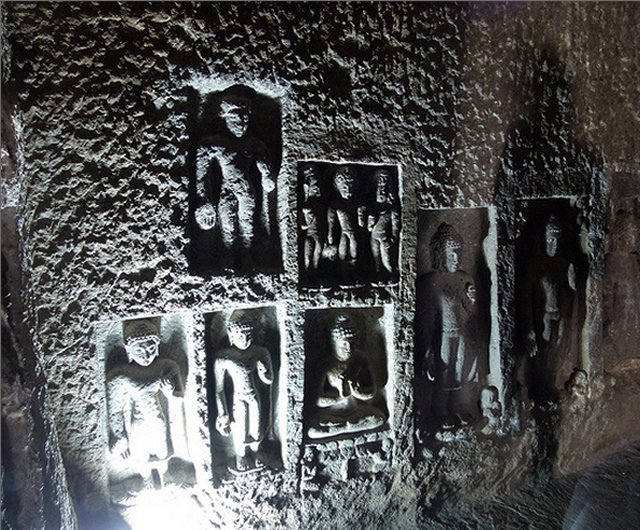First version of this article was originally published on July 26, 2014
MessageToEagle.com – Now, it’s time to take a look at the next architectural wonder of India – the cave temples of Ajanta – that represent a symbol of unexplained sophisticated technology of the ancient builders of India.
Several of India’s cave temples are very famous, like for example Ellora – the largest single rock-cut temple, we described in our previous article.
So far, there are about 1,200 cave temples still in existence, in India. Some 1,000 of them are located in the western state of Maharastra, India. Others are located in the northeastern state of Bihar and in Karnataka to the south of Maharastra, with a few scattered throughout other states.

Hewn out of the horse-shoe shaped stone cliffs surrounding the River Waghora, the Ajanta Caves consists of several viharas (monastic halls of residence) and chaitya-grihas (stupa monument halls)are located in the western Indian state of Maharashta, just 55 km from Jalgaon city and only 105 km from the famous Ellora Caves, in Aurangabad City.
By 480 AD the caves at Ajanta were abandoned and during the next 1300 years the jungle grew back.
Hidden, unvisited and undisturbed until 1819, the rock-cut temples were accidentally rediscovered by a British Army officer, John Smith, who is believed to have been in the group of the first recorded visitors to the caves.
The temples were sculptured by Hindus, Jains and Buddhists, and according to standard textbook opinion, their age is that the earliest were carved around 300 BCE but most in the period of the 4th to the 9th centuries CE.
However, according to H. P. Blavatsky some of these complexes date to a much more remote period and were ancient mystery schools built on labyrinths of still other caves which have not been discovered.
She asks:
Why, then, could not Ellora, Elephanta, Karli, and Ajanta have been built on subterranean labyrinths and passages, as claimed? Of course we do not allude to the caves which are known to every European, whether de visu or through hearsay, notwithstanding their enormous antiquity, though that is . . . disputed by modern archaeology.
But it is a fact, known to the Initiated Brahmins of India and especially to Yogis, that there is not a cave-temple in the country but has its subterranean passages running in every direction, and that those underground caves and endless corridors have in their turn their caves and corridors…” – H. P. Blavatsky, The Secret Doctrine
Some of the India’s cave temples have been incorporated into Jain and Hindu temples which are built on top of or around them and have often been restyled, so they have lost much of their original appearance.
Today some researchers of India’s cave temples admit that almost nothing is known about their origin and builders; others use the doubtful dates provided by most textbooks, often based on little and/or controversial evidence.
Esoteric Brahmanic tradition relates that these caves were once linked to underground tunnels with secret entrances, though no such entrances have been found, and these tunnels were supposedly built by the Nephilim, or “men of the golden age, writes D.H. Childress in his book “Lost Cities of China, Central Asia and India“. ‘
And he continues:
“the Ajanta caves, famous for their Buddhist frescoes, generally depicting the life of Buddha. There are twenty-nine caves altogether, carved into a rock cliff that is well hidden. It was here that hundreds of Buddhist monks lived and worked. A certain mystery hangs over these magnificent frescoes. They have a richness of color and glow with a depth that is highly sophisticated and unusual.
The artists used some unknown type of special luminous paint that makes the paintings stand out and come alive. When the lights are turned off, gradually the figures on the wall appear to be three-dimensional as if they were made of marble. The secret of the fantastic effect obtained by clever deployment of this luminous paint is no longer known…”
Moreover, these priceless historical monuments are still very controversial regarding not only their origin but also their creators. Even the sacred symbolism, which should be an extremely strong link connecting them all, has been debased.
See also:
Vijayanagara – The City Of Devas – ‘The Shining Ones’ – Place Where Mythology And History Coexist
11 Mysterious Ancient Underground Worlds That Remain Unsolved To This Day
Yungang Grottoes: Marvellous Example Of Ancient Buddhist Rock-Cut Architecture
India’s cave temples – originally carved by Hindus – could not maintain their true origin because they were more or less extensively restyled resculptured, plastered, and painted) at a later date by Buddhist.
Still, the Ajanta’s paintings and their infinite charm represent an extraordinary art because they belong to a period which was ancient and to a land which was Eastern rather than Western.
Incidentally they contain the scenes of semi-mythological history, the royal court and popular life of the ancient times, as told in romances and plays. Some pictures recall the Greek and Roman compositions and proportions, few late resemble to Chinese manners to some extent.
But majority belongs to a phase, which is purely Indian, as they are found nowhere else.
Copyright © MessageToEagle.com. All rights reserved. This material may not be published, broadcast, rewritten or redistributed in whole or part without the express written permission of MessageToEagle.com.







